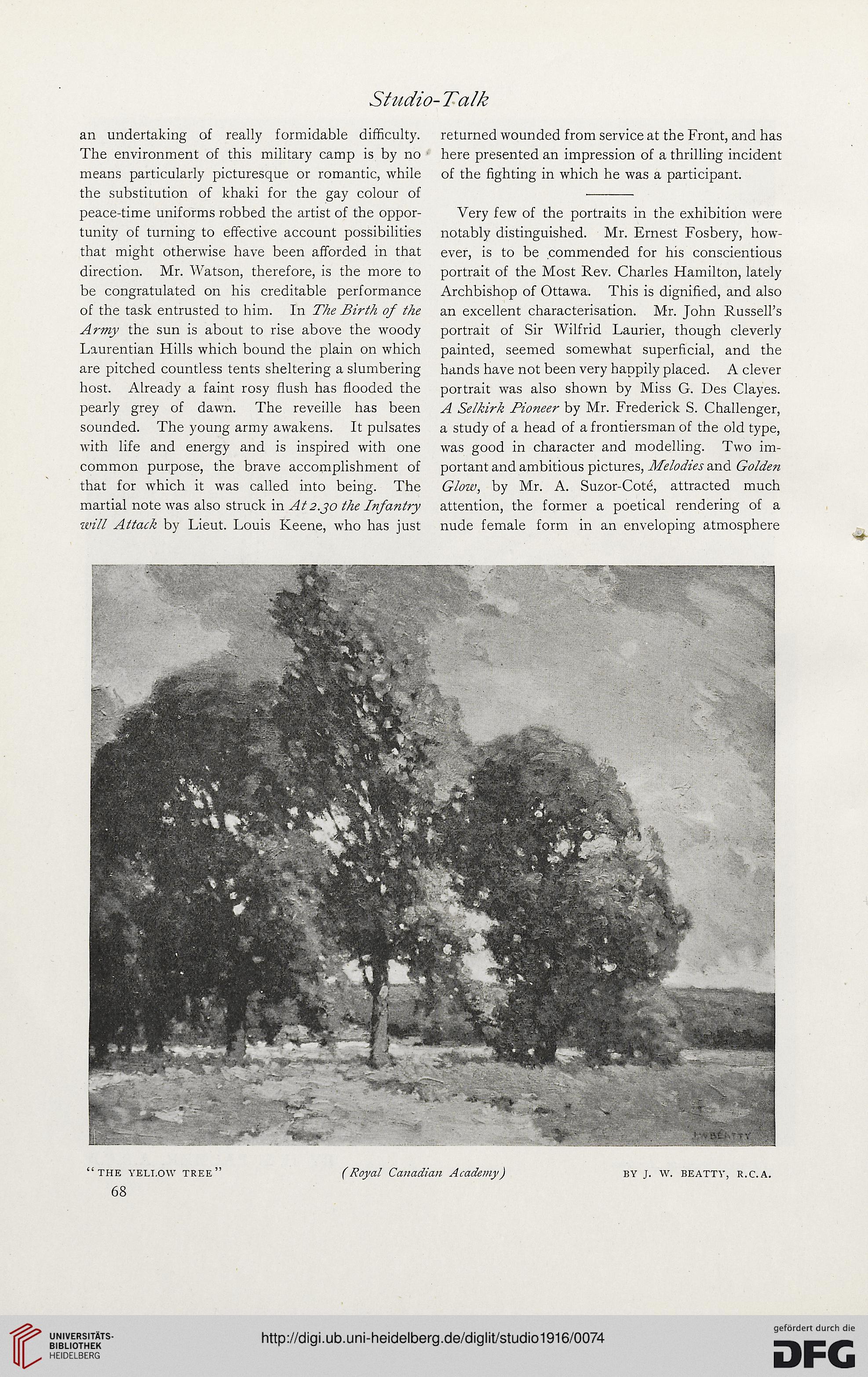Studio- Talk
an undertaking of really formidable difficulty.
The environment of this military camp is by no
means particularly picturesque or romantic, while
the substitution of khaki for the gay colour of
peace-time uniforms robbed the artist of the oppor-
tunity of turning to effective account possibilities
that might otherwise have been afforded in that
direction. Mr. Watson, therefore, is the more to
be congratulated on his creditable performance
of the task entrusted to him. In The Birth of the
Army the sun is about to rise above the woody
Laurentian Hills which bound the plain on which
are pitched countless tents sheltering a slumbering
host. Already a faint rosy flush has flooded the
pearly grey of dawn. The reveille has been
sounded. The young army awakens. It pulsates
with life and energy and is inspired with one
common purpose, the brave accomplishment of
that for which it was called into being. The
martial note was also struck in At 2.jo the Infantry
will Attack by Lieut. Louis Keene, who has just
returned wounded from service at the Front, and has
here presented an impression of a thrilling incident
of the fighting in which he was a participant.
Very few of the portraits in the exhibition were
notably distinguished. Mr. Ernest Fosbery, how-
ever, is to be commended for his conscientious
portrait of the Most Rev. Charles Hamilton, lately
Archbishop of Ottawa. This is dignified, and also
an excellent characterisation. Mr. John Russell’s
portrait of Sir Wilfrid Laurier, though cleverly
painted, seemed somewhat superficial, and the
hands have not been very happily placed. A clever
portrait was also shown by Miss G. Des Clayes.
A Selkirk Pioneer by Mr. Frederick S. Challenger,
a study of a head of a frontiersman of the old type,
was good in character and modelling. Two im-
portant and ambitious pictures, Melodies and Golden
Glow, by Mr. A. Suzor-Cote, attracted much
attention, the former a poetical rendering of a
nude female form in an enveloping atmosphere
an undertaking of really formidable difficulty.
The environment of this military camp is by no
means particularly picturesque or romantic, while
the substitution of khaki for the gay colour of
peace-time uniforms robbed the artist of the oppor-
tunity of turning to effective account possibilities
that might otherwise have been afforded in that
direction. Mr. Watson, therefore, is the more to
be congratulated on his creditable performance
of the task entrusted to him. In The Birth of the
Army the sun is about to rise above the woody
Laurentian Hills which bound the plain on which
are pitched countless tents sheltering a slumbering
host. Already a faint rosy flush has flooded the
pearly grey of dawn. The reveille has been
sounded. The young army awakens. It pulsates
with life and energy and is inspired with one
common purpose, the brave accomplishment of
that for which it was called into being. The
martial note was also struck in At 2.jo the Infantry
will Attack by Lieut. Louis Keene, who has just
returned wounded from service at the Front, and has
here presented an impression of a thrilling incident
of the fighting in which he was a participant.
Very few of the portraits in the exhibition were
notably distinguished. Mr. Ernest Fosbery, how-
ever, is to be commended for his conscientious
portrait of the Most Rev. Charles Hamilton, lately
Archbishop of Ottawa. This is dignified, and also
an excellent characterisation. Mr. John Russell’s
portrait of Sir Wilfrid Laurier, though cleverly
painted, seemed somewhat superficial, and the
hands have not been very happily placed. A clever
portrait was also shown by Miss G. Des Clayes.
A Selkirk Pioneer by Mr. Frederick S. Challenger,
a study of a head of a frontiersman of the old type,
was good in character and modelling. Two im-
portant and ambitious pictures, Melodies and Golden
Glow, by Mr. A. Suzor-Cote, attracted much
attention, the former a poetical rendering of a
nude female form in an enveloping atmosphere




